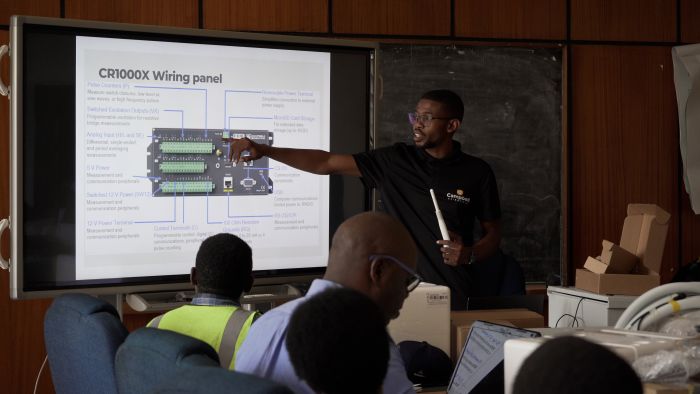









概要
2019 年 5 月、ザンビア政府は世界銀行の資金援助による気候適応水・エネルギーインフラプログラム (CAWEP) プロジェクトに着手しました。このプロジェクトの重要な側面の 1 つは、気候と水文気象データを活用して気候変動に対するレジリエンスを構築する国の能力を強化することです。ザンビアの地理的および気候的多様性には、国民の天気予報と気候レジリエンスを強化するための包括的で信頼性の高い気象ネットワークが必要です。
課題
CAWEP が発足する前、ザンビアの気象ネットワークは手動と自動の気象観測所が混在しており、カバー範囲は全国的に不均一でした。同国は気候変動に対して脆弱であるため、この限られたネットワークでは気象予測の精度が妨げられ、農業からインフラ開発までさまざまな分野に悪影響を及ぼしていました。
解決策
これらの課題に対処するため、Campbell Scientificは、ザンビア全土に 120 基の自動気象観測所 (AWS) を供給し設置する任務を委託されました。この事業の範囲は広範かつ要求が厳しく、綿密な計画と実行が必要でした。信頼性、耐久性、操作のシンプルさで定評のある当社の気象観測所は、この役割に最適でした。MQTT 機能を備えた当社の CR1000X 計測および制御データロガーは、世界気象機関 (WMO) 情報システム 2.0 (WIS 2.0) へのシームレスなデータ転送を容易にし、これらの気象観測所を WMO の要件に合わせます。この機能は、地球規模基本観測ネットワーク (GBON) のデータ ギャップを埋める世界的な取り組みに大きく貢献します。
GBON は、地球規模の地表ベースのデータにおける重大なギャップに対処し、世界中の気象および気候サービスの品質に影響を与えます。2021 年に WMO の 193 の加盟国が合意した GBON 標準の実装は、国際的なデータ交換における変革的な一歩となります。
GBON および準拠した監視ソリューションの詳細をご覧ください。
気象観測所ネットワークの設置に加えて、プロジェクトの長期的な持続可能性を確保するために、技術者と気象データユーザーに対する包括的なトレーニングも作業範囲に含まれていました。
プロジェクトの円滑な実施を確実にするために、私たちは地元の請負業者と協力し、知識移転と雇用創出を通じて地元のエンパワーメントを実現しました。作業範囲には土木工事(基礎工事とフェンス設置)が含まれていました。チームは起伏の多い地形と、車両故障につながることが多い困難な道路状況に対処する必要があり、プロジェクトは困難を極めました。私たちのプロジェクトへの取り組みは、機材の輸送に小型の手漕ぎボートが不可欠だった川の横断にまで及びました。さらに、私たちのスタッフのうち2人は、厳しい地形を通り抜け、遠隔地の気象観測所にアクセスするために、上級の4x4運転コースを修了しました。
トレーニング
CAWEP プロジェクトの一環として、ザンビア気象局 (ZMD) とそのパートナーを対象に、包括的な 3 日間のトレーニング プログラムを実施しました。このトレーニングでは、AWS のインストール、操作、メンテナンスのほか、アーカイブおよびバックアップ システムを備えたネットワーク管理ツールの使用方法についても学習しました。
お客様にデータ ロガーとソフトウェアに関する詳細な知識を提供することで、お客様は自信を持って自社の機器を管理できるようになります。各センサーの機能を理解し、エラー検出に熟達することで、メンテナンスに対する積極的なアプローチが促進されます。この専門知識をお客様に提供することで、当社は個々のプロジェクトの成功だけでなく、自立した有能な気象監視専門家のグループを作るというより広い目標にも貢献しています。知識を共有することで回復力を構築し、世界中の気象監視システムの寿命と有効性を確保できると考えています。
メリット
このプロジェクトの影響は多岐にわたり、広範囲に及ぶものとなるでしょう。
- 生活の向上:より高密度の気象ネットワークにより、ザンビアは重要な気象および気候情報を入手し、さまざまな経済セクターの生活向上に貢献します。正確な天気予報により、農家は十分な情報に基づいた意思決定を行うことができ、農業生産性の向上につながります。
- 気候耐性インフラ:拡張されたネットワークは、主要なインフラ プロジェクトを気候耐性にするために必要な基礎情報を提供し、投資を保護し、長期的な持続可能性を確保します。
- 地球規模の気象監視:ザンビアの地球規模の気象監視と予報への貢献の拡大により、世界の気候パターンに対する理解が深まり、気候変動への取り組みにおける国際協力が促進されます。
当社の取り組みの一環として、AWS ネットワークのインストール、運用、保守を行うための継続的なトレーニングと技術サポートを ZMD スタッフに提供しています。当社の包括的なトレーニング スケジュールにはシステムのあらゆる側面が網羅されており、ZMD がこの重要なネットワークを管理するのに十分な能力を備えていることを保証します。
最後に、キャンベル サイエンティフィックは、ザンビアの CAWEP プロジェクトで役割を果たし、同国が開発と回復力のために気候データの力を活用できるようにしたことを光栄に思います。当社は、この変革的な取り組みの持続的な成功を確実にするために、継続的な技術サポートとトレーニングを提供することに専念しています。協力することで、ザンビアは気象観測所を 1 つずつ設置し、気候の課題に直面しても繁栄する力を得ています。